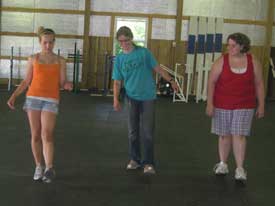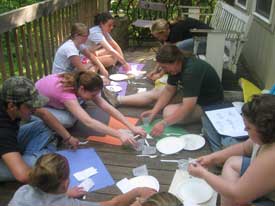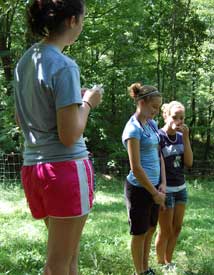Thanks to Luca Canever for the Italian translation and Doris Vaterlaus for the French and German translations and for putting it all together in multi-color!
Download the translations as a PDF
Download the glossary in English only
TAGteach Glossary of Terms
The development of
TAGteach needs a new terminology in order to give TAGteachers a common language
to enable them to communicate more efficiently with their students and each
other.
Some terms are
marked with the TM; this means that these are registered trade marks. If they
are published in an article or a publication, they have to be marked with the
TM at first use.
TAGteach Glossar
(Deutsche Übersetzung D. Vaterlaus)
Die Entwicklung von TAGteach bedingt eine neue Terminologie,
um TAGteachern eine gemeinsame Sprache zu geben, die Kenntnisse und Erfahrungen
vereint und ihnen ermöglicht, effizienter mit ihren Studenten zu kommunizieren.
Einige Ausdrücke sind mit der Trade Mark TM ausgezeichnet; dies
bedeutet, dass es sich hier um registrierte Bezeichnungen handelt. Wenn diese
in einem Artikel oder einer Publikation verwendet werden, müssen sie bei der
ersten Verwendung mit einem TM gekennzeichnet werden.
TAGteach Glossaire
(traduction française D. Vaterlaus)
Le
développement du TAGteach implique l’utilisation d’une nouvelle terminologie
afin de donner aux TAGteachers un langage commun pour réunir connaissances et
expériences et leur permettre de communiquer plus efficacement avec leurs
étudiants.
Quelques
expressions sont suivies du sigle TM, ce qui veut dire que ce sont des termes
de marque déposée. S’ils sont utilisés dans un article ou une publication, ils
doivent être is de TM lors de leur premier usage.
TAGteach Glossar
(traduzione italiana Luca Canever)
Lo sviluppo del TAGteach implica
l’uso di una nuova terminologia,
in modo tale da dare ai TAGteachers un linguaggio comune su cui condividere
conoscenze e d esperienze e permettere loro di comunicare più efficacemente con
i loro studenti.
Una nota: alcuni termini sono seguiti dalla dicitura TM scritta in apice, ad
indicare che questi sono termini a marchio depositato.
Nel caso vengano utilizzato in un articolo o una pubblicazione, devono essere
seguiti da TM al loro primo utilizzo.
Applied
Behavior Analysis
The field of science
from which TAGteach and other reinforcement-based teaching and training
technologies have been developed.
Angewandte Verhaltensforschung
(englisch ABA)
Das Forschungsgebiet
in dem TAGteach und andere verstärkerbasierte Lehr- und Lernmethoden entwickelt
wurden.
Analyse de comportement appliquée (en
anglais ABA)
Un champ de recherche
ou TAGteach et d’autres méthodes
d’apprentissage et
d’entraînement ont été développé
Analisi Applicata Del Comportamento
Il campo della ricerca scientifica dal
quale sono state sviluppate il TAGteach e le altre tecniche d’insegnamento e
allenamento basate sul Rinforzo
_________________________________________________
Behavior
Physical activity in
general; or a specific movement or group of related movements (‘a behavior’).
Verhalten
Körperliche Aktivität
im Generellen oder eine spezifische Bewegung oder eine Gruppe von
zusammengehörenden Bewegungen („ein Verhalten“)
Comportement
Activité physique ou
un mouvement spécifique ou groupe de mouvements („un comportement)
Comportamento
Attività fisica in generale; il termine può riferirsi anche a uno
specifico movimento o a una serie di movimenti legati tra loro. In ogni caso si
tratta di una risposta, emessa dall’individuo, a uno stimolo.
_________________________________________________
Conditioned
Reinforcer
Any stimulus that has
acquired positive reinforcing properties through association with other
reinforcers such as food, praise or success. [The tagger is a conditioned
reinforcer -providing a positive stimulus that occurs simultaneously with a
desired act or response.]
Konditionierter
Verstärker
Irgendein
Auslöser, der positive Verstärkereigenschaften durch die Assoziation mit
Verstärkern wie Futter, Lob oder Erfolg bekommen hat.
Renforcement conditionné
Chaque stimulus
renforcé positivement en l’associant à des „renforçateurs“ tels que nourriture,
compliments ou succès,
Rinforzo Condizionato
Qualsiasi stimolo che abbia acquisito proprietà di rinforzo positivo
attraverso la sua associazione (pareggiamento) con altri rinforzi quali cibo,
elogi o avere successo. Il tag (cfr infra) è un rinforzo condizionato che offre
uno stimolo simultaneo a un’azione o a un gesto che così vengono rinforzati.
_________________________________________________
Focus Fatigue
Mental fatigue that
occurs when a tag session is too long for a particular learner.
Verlust des Fokus
Konzentrationsverlust.
Geistige Müdigkeit, die entsteht, wenn eine tag Sitzung für einen individuellen
Lernenden zu lange dauert.
Perte de la cible
Perte de
concentration. Fatigue intellectuelle qui se développe quand une séance tag
dure trop longtemps.
Stanchezza Dell’attenzione
Stanchezza mentale che avviene quando una sessione di TAGteach è troppo
lunga per l’allievo.
_________________________________________________
Focus FunnelTM
A technique used in
planning and teaching. Beginning with a broad lesson, information is
reduced into more concrete directions and then reduced again to a precise tag
point. (Also see reverse focus funnel)
Fokus TrichterTM
Eine Technik, welche
für die Planung oder das Lehren verwendet wird.
Es wird mit einer
groben Lektionserklärung begonnen, auf konkretere Anweisungen reduziert und
dann nochmals auf einen präzisen Tag Punkt reduziert.
(s. auch den
umgekehrten Fokus Trichter)
L’entonnoir de la concentrationTM
Technique utilisée
pour la planification ou l’apprentissage.
Le début consiste en
une explication générale de la leçon puis à des directives contrêtes et enfin
réduit à un point tag précis..
v.aussi la cible
élargie.
Imbuto Dell’attenzioneTM
Una tecnica usata nella pianificazione e nell’insegnamento. Iniziando da
una ampia lezione, l’informazione è ridotta in direzioni più concentrate ed
ulteriormente ridotta fino a un preciso tag point. (vedi anche Imbuto
dell’attenzione Inverso)
_________________________________________________
Incompatible
behavior
Short for
differential reinforcement of incompatible behavior (DRI). Eliminate a
designated behavior by strengthening other behaviors that are incompatible with
it.
Inkompatibles Verhalten
Ist die Abkürzung für
DRI = differenzierende Verstärkung (Reinforcement) von inkompatiblem Verhalten.
Eliminiert ein bestimmtes Verhalten, indem man andere Verhalten verstärkt, die
mit dem ursprünglichen Verhalten inkompatibel sind.
Comportement incompatible
Raccourci DRI –
(differential reinforcement of incompatible behavior – renforcement différencié
d’un comportement incompatible). Elimine un comportement spécifique en
renforçant d’autres comportements qui sont incompatibles avec le comportement
initial.
Comportamento Incompatibile
La definizione fa riferimento al rinforzare selettivamente comportamenti
incompatibili con quello indesiderato
emesso dall’allievo (in inglese DRI = Differential Reinforcement of
Incompatible behavior. Per esempio: rinforzare il rimanere seduto per un
bambino “vivace”. Stare seduto su una sedia è incompatibile con altri
comportamenti quali il correre in giro).
Con comportamento desiderato facciamo riferimento a un
comportamento emesso dall’allievo, compatibile con l’ambiente (naturale o
culturale) e con le nostre aspettative.
________________________________________________
Operant
Conditioning
Any procedure by
which a behavior becomes more or less likely to occur, depending on its
consequences. [In TAGteach, the consequences are always positive and desired
responses become more likely to occur.]
Operante Konditionierung
OK ist ein Verfahren,
das dazu führt, dass ein Verhalten mehr oder weniger häufig auftritt, abhängig
von dessen Folgen. (Im TAGteach sind die Konsequenzen immer positiv und
gewünschte Reaktionen werden immer häufiger gezeigt).
Conditionnement opérant
CO est un procédé qui
indique qu’un comportement apparaît plus ou moins souvent et qui dépend de ses
conséquences. (Dans le TAGteach, les conséquences sont toujours positives et
les réactions désirées se manifestent de plus en plus souvent.
Condizionamento Operante
Qualsiasi procedura
attraverso la quale un comportamento diventa più o meno probabile in base alle
sue conseguenze. (Nel TAGteach
le conseguenze sono sempre positive e i comportamenti desiderati aumentano la
probabilità di venire emessi).
_________________________________________________
Peer TaggingTM
Student-to-student
tag configurations and activities.
Gegenseitiges TaggenTM
Tag-Anordnungen oder -Aktivitäten
zwischen Student und Student
Le TAGGING entre partenairesTM
Des configurations et
acitivités TAG exécutés entre 2 étudiants.
Peer TaggingTM
(Taggarsi Tra Compagni)
Attività o configurazioni d’attività
che vengono realizzate tra studente e studente. In questo casi il ruolo
dell’insegnate è quello di fornire le linee guida all’attività ed,
eventualmente, sovraintendere alla stessa nel caso in cui ulteriori indicazioni
siano necessarie.
In alcuni casi, come questo lascio
la definizione in inglese, visto che la traduzione in italiano non “suona
bene”.
_________________________________________________
Point of
SuccessTM
A behavior to start
or to repeat, for which the student is guaranteed a tag.
ErfolgspunktTM
Ein Verhalten zu
beginnen oder zu wiederholen, für welches der Student garantiert einen tag bekommt.
Point de SuccesTM
Début ou répétition
d’un comportement pour lequel l’édutiant aura un tag garanti.
Punto Di SuccessoTM
E’ un comportamento che l’allievo può sicuramente emettere con successo,
ricevendo un tag. All’inizio di ogni sessione di TAGteach è bene che il primo
tag point sia un punto di successo. In questo modo lo studente può trovare da
subito rinforzante l’insegnamento.
_________________________________________________
Positive
Reinforcement
A procedure in which
a behavior is paired with a desired stimulus or event that will increase the
chance of the behavior happening again in the future.
Positive
Bekräftigung
PB bedeutet,
dass ein Verhalten mit einem gewünschten Auslöser oder Resultat gekoppelt wird,
was die Chance erhöht, dass dieses Verhalten in Zukunft immer wieder gezeigt
wird.
Renforcement positif
RF signifie qu’un
comportement est combiné avec un stimulus désiré ou un évènement qui a pour but
d’augmenter la chance de voir ce comportement manifesté plus souvent à l’avenir.
Rinforzo Positivo
Una procedura con la quale un comportamento è associato con uno stimolo
positivo (desiderato). Il termine Rinforzo Positivo, fa anche riferimento a un
evento che aumenta le probabilità per un comportamento di venire emesso in futuro.
_________________________________________________
Reverse Focus
Funnel
Deliver the least
amount of information necessary for success first (tag point). Once the
behavior has been accomplished, and the learner is more confident, additional information
can be delivered. This is useful in situations where too much information
may overwhelm the learner and cause a loss of concentration.
Umgekehrter Fokus Trichter
Vermittlung der
kleinstmögliche Anzahl von notwendigen Information zum Erfolg (tag punkt). Wenn
das Verhalten einmal erreicht wurde und der Lernende mehr Vertrauen gewonnen
hat, können zusätzliche Informationen vermittelt werden.
Dies ist notwendig,
wenn zu viel Information den Lernenden überfordern und zu einem
Konzentrationsverlust führen könnte
L’entonnoir en sense inverse
Transmet un minimum
d’informations nécessaires au succès (point tag). Si le comportement est atteint
et l’édudiant a acquis plus de confiance, des informations supplémentaires
peuvent être fournis.
C’est le cas ou trop
d’informations surchargent l’étudiant ou peuvent mener à une perte de
concentration.
Imbuto Dell’attenzione Inverso
Procedura attraverso la quale viene fornita la minore quantità possibile
d’informazione affinchè l’allievo possa avere subito successo. Nel momento in
cui il comportamento è stato emesso e l’allievo ha acquistato maggior
confidenza, è possibile aggiungere ulteriore informazione. Questa procedura si
rivela utile quando troppa informazione può sommergere l’allievo e causare una
perdita di concentrazione.
_________________________________________________
Shaping
An operant
learning procedure in which small increments of a desired response are
reinforced. By reinforcing some small response, and then selecting
stronger or longer occurrences, one can ‘shape’ or build a more elaborate
behavior.
Shaping / Formen
Ein operantes
Lernverfahren, bei welchem kleine Einheiten einer erwünschten Reaktion
verstärkt werden. Indem kleine Reaktionen verstärkt werden und dann stärkere
und längeres Auftreten dieser ausgewählt werden, kann man besser ausgeführte
Verhalten „formen“ oder „herausbilden“
Shaping / former
C’est un procédé
d’apprentissage où de petites unités d’une réaction désirée sont renforcées. En
choisissant et renforçant des manifestions plus intenses et plus longes, on
peut induire un comportement plus élaboré.
Shaping (Modellamento)
Una procedura di condizionamento operante attraverso la quale si
rinforzano piccole approssimazioni successive verso il comportamento
desiderato. Rinforzando piccole risposte e selezionando in seguito più forti o
lunghe emissioni è possibile modellare un comportamento più complesso.
_________________________________________________
Stimulus
Something in the
environment that can be sensed - a sound, an object, a color, etc. A
discriminative stimulus is something the learner can perceive which indicates
an action to be taken (for example a red light is a stimulus to step on the
brake).
Stimulus / Auslöser
Etwas in der Umgebung
kann eine Bedeutung bekommen – ein Geräusch, ein Gegenstand, eine Farbe, etc.
Der Lernende kann einen Auslöser erkennen/wahrnehmen, und dieser führt zur
Ausführung einer Handlung.
(zum Beispiel: ein
rotes Licht ist ein Auslöser, um auf das Bremspedal zu drücken).
Stimulus / déclencheur
Quelque chose dans
l’environnement peut avoir de l’importance – un son, un objet, une couleur, etc.
L’étudiant peut convevoir, percevoir le stimulus qui mène à l’exécution d’une
action. P.ex: un feu rouge est le déclencheur pour presser sur la pédale des
freins.
Stimolo
Qualcosa dell’ambiente che può essere percepito (un suono, un oggetto un
colore). Uno stimolo discriminativo è qualcosa che può essere percepito
dall’allievo e che indica quale comportamento emettere (ad esempio il rosso del
semaforo è uno stimolo discriminativo per schiacciare il pedale del freno)o
quale comportamento è stato appena marcato per essere rinforzato.
_________________________________________________
Marker
Something which
"marks" or identifies a desired action. Typically a TAGteach
marker emits a brief, distinct, uniform stimulus used to pinpoint movement as
it is happening; a click from a ball point pen, a clicker, hand clap, a finger
snap. Some Smart phone applications provide appropriate marker tones.
Marker
Mit einem Marker wird
eine gewünschte Handlung „markiert“ oder identifiziert. Ein TAGteach Marker
vermittelt einen kurzen, genauen, und eindeutigen Ton, um eine Bewegung genau
im Moment wenn sie passiert hervorzuheben: das Klicken eines Kugelschreiber,
ein Clicker, ein Handklatschen, ein Fingerschnipsen. Einige Smartphone
Anwendungen liefern passende
Markertöne.
Marquer
Avec un marquer une action désirée est „marquée“ ou identifiée. Le marquer
TAGteach émet un son court, précis et clair (univoque) pour indiquer un
mouvement juste au moment où il se manifeste: le Clic d’un stylo à bille, un
cliquer, claquer des mains, des doigts.
Quelques applications sur les smartphones proposent des sons de marquers
appropriés.
Marker
Qualcosa che “marca”, identificando ed esaltando, un’azione desiderata.
Solitamente il marker usato nel TAGteach emette un breve stimolo, uniforme e
distinto, utlizzato per identificare l’azione nell’istante in cui questa
avviene. Il click di una penna, un clicker, far schioccare le dita. Alcuni
smartphone hanno delle applicazioni da poter usare come marker sonori.
_________________________________________________
Tag
As a verb it is the
action of marking someone's correct behavior (as in “tag for each
blink”). As a noun, it means the mark that is placed on a correct
behavior (as in “You got 5 tags today!”). (see Marker)
Tag / Taggen
Das Substantiv „tag“
meint das Platzieren der Markierung für das korrekte Verhalten (z.B. „ Du hast
heute 5 tags bekommen“) s. auch „Marker“.
Das Verb „Taggen“ bedeutet das Markieren von einem korrekten Verhalten (wie
z.B. „taggen für jedes Blinzeln“)
Tag / tagguer
Le substantif tag
signifie le marquage d’un comportement approprié (.p.ex. „aujourd’hui tu as
reçu 5 tags) – voir également „Marker“.
Le verbe „tagguer“
signifie l’identification d’un comportement correct (p.ex. „tagguer pour chaque
clignotement“)
Tag
Utilizzato come un verbo corrisponde all’azione di “marcare” il
comportamento corretto. Utilizzato come sostantivo indica il segnale che viene
messo in corrispondenza del comportamento desiderato. (vedi Marker)
Tagger
Fa riferimento sia al
dispositivo che emette il suono (noto anche come Clicker); sia alla persona che
lo sta usando.
_________________________________________________
Tag Phrasing
The wording used for
preparing and delivering tag points (see WOOF)
Tag Vokabular
Die Wortwahl, welche
zur Vorbereitung und dem Abgeben von TAG Punkten verwendet wird (s.a. WOOF)
Le vocabulaire Tag
Le choix de mots
utilisés prépare et donne des points TAG (v. également WOOF)
Tag Phrasing (Le Tag-Indicazioni)
Le parole che vengono utilizzate per preparare ed assegnare i tag point
(per esempio: “il tag point è….”)
______________________________________________________
Tag PointTM
The specific aspect
of a behavior that when/as performed will receive the audible mark (tag). (see
WOOF for tag point criteria)
TAG PunktTM
Ein spezieller Teil
eines Verhaltens erhält einen hörbaren Marker (tag) wenn es gezeigt wird.
TAG PointTM
Un aspect spécifique
d’un comportement obtient un marquer (tag) si celui-ci est exécuté.
Tag PointTM
Lo specifico aspetto
di un comportamento che, nel momento in cui viene emesso, riceve il marker
sonoro. (vedi la voce WOOF per i criteri del tag point). Un tag point acquista
un valore aggiunto nel momento che riesce a risolvere più di un problema (per
esempio il tag point “metti le chiavi in tasca” eviterà di smarrire le chiavi,
o, peggio, chiuderle dentro la macchina). Il tag point deve essere dato usando
cinque parole o meno.
_________________________________________________
Tag TriangleTM
The three components
of the TAGteach process: Identify, Mark and Reinforce.
TAG DreieckTM
Die drei Bestandteile
des TAGteach Prozesses: Idenfizieren, markieren und bekräftigen.
Le Triangle
TAGTM
Les trois composants
du processus TAGteach:
Identifier,
marquer et renforcer.
Il Triangolo Del TagTM
Sono i tre componenti del TAGteach inteso come processo d’insegnamento:
Identificare, Marcare e Rinforzare
________________________________________________
TAGteachTM
TAGteach is a
protocol that promotes positive interactions for increased productivity and
success. The acronym TAG stands for Teaching with Acoustical Guidance and
refers to the audible marker, a key tool used in the system designed to
highlight success. The TAGteach protocol also includes tools to deliver
information, reduce inefficient language, assess performance, create confidence
and deliver positive reinforcement.
TAGteachTM
TAGteach ist
ein Protokoll welches positive Wechselwirkungen für erhöhte Produktivität und
Erfolg fördert. Das Akronym TAG steht für Lehren mit akustischer Hilfe und
bezieht sich auf den hörbaren Marker, ein Schlüsselwerkzeug, welches verwendet
wird, um den Erfolg hervorzuheben.
Das TAGteach
Protokol beinhaltet auch Werkzeuge zur Vermittlung von Information, reduziert unnötige Sprache, bestätigt die
Ausführung, bildet Vertrauen und gibt positive Bekräftigung ab.
TAGteachTM
TAGteach est un
protocol qui favorise les actions réciproques pour augmenter la productivité et le succès.
TAG est un acronym
qui se réfère à l’apprentissage avec support acoustique qui renforce le succès
Le protocole TAG
ajoute des outils pour donner l’informaton, diminuer le langage inutile,
augmenter les performances, créer la confiance et donner un renforcement
positif.
TAGteachTM
Si tratta di un protocollo che promuove le interazioni positive che
migliorano il successo e la produttività. L’acronimo TAG significa (Teaching
with Acoustical Guidance) e fa riferimento al marker sonoro, uno strumento
chiave utilizzato in questa tecnologia per sottolineare il successo. Il
protocollo del TAGteach include anche strumenti per fornire l’informazione,
ridurre l’inefficacia del linguaggio, stabilire il da farsi, creare confidenza
e dare Rinforzo Positivo.
_________________________________________________
TagulatorTM
A device made from
beads that slide on a string that allows the teacher or learner to keep track
of the number of tags they have earned or given.
TagulatorTM
Gegenstand, der
aus Perlen besteht, die an einer Schnur hangen.
Dieser erlaubt
dem Lehrer oder Lernenden die Anzahl Tags zu zählen/kontrollieren, die er
verdient oder erhalten hat.
TagulateurTM
Objet composé de
perles attachées à une ficelle. Cet objet permet au maître ou étudiant de compter ou contrôler le nombre de tags, gagnés ou
reçus.
TAGULATORTM
Uno strumento fatto di perline che scivolano su un cordino permettendo all’insegnante
o all’allievo di tener conto dei tag che hanno dato o guadagnato.
_________________________________________________
Three try ruleTM
If a learner fails to
perform the designated tag point three times, the teacher creates and delivers
a more achievable tag point. The three try rule is more of a guide than a
rule. Some learners want to work things out for themselves and will try several
times without getting discouraged. Others would rather take very small steps
forward and succeed nearly every time.
Regel der drei VersucheTM
Wenn der Lernende den
definierten Tag Punkt drei Mal nicht ausführen kann, kreiert und definiert der
Lehrer einen einfach zu erreichenden Tag Punkt. Die Regel der drei Versuche ist
eher eine Richtschnur als eine Regel. Einige Lernende wollen etwas von sich aus
erarbeiten und verschiedene Versuche machen, ohne enttäuscht zu sein. Andere
möchten eher sehr kleine Schritte vorwärts machen und brauchen jedes Mal einen
Erfolg.
La règle des trois essaisTM
Si l’étudiant ne peut
pas obtenir le point tag 3x de suite, le maître définit un point tag plus
facile à atteindre. La régle des trois essais est plus un objectif qu’une
règle. Quelques étudiants préfèrent agir eux-mêmes et faire différents essais,
sans être déçus. D’autres préfèrent avancer à petits pas et ont chaque fois
besoin de succès.
Regola Delle Tre ProveTM
Se un allievo non riesce ad eseguire il tag point assegnatogli in tre
ripetizioni, l’insegnante crea e indica un tag point più semplice. La regola
delle tre prove è più una linea guida che una regola vera e propria. Alcuni
allievi vogliono riuscire da soli e saranno in grado di provare anche molte
volte senza scoraggiarsi; altri possono preferire ottenere piccoli ma costanti
successi.
_________________________________________________
Value Added Tag
Point
A single tag point in
which more than one problem may be resolved. [e.g., The tag point “Put
keys in pocket”, would keep the keys from being misplaced and from being
locked in the car.)
TAG Punkt mit Mehrwert
Ein einzelner Tag
Punkt, mit welchem mehr als ein Problem gelöst werden kann
(z.B.
„Schlüssel in die Tasche“, hilft, dass die Schlüssel nicht an den falschen Ort
gelangen und nicht im Auto eingeschlossen werden).
Le point TAG avec valeur additionnelle
Un point tag peut
résoudre plus qu’un seul problème, p.ex. „Les clés dans la poche“ évite que les
clés soient posées au mauvais endroit et
pourraient être enfermées dans la voiture.)
In Italiano - added to Tag Point.
_________________________________________________
WOOFTM
The acronym defining
the four criteria for a tag point: What you want, One criterion, Observable
and definable, Five words or less
WOOFTM
Das Akronym definiert
die vier Kriterien für einen Tag Punkt:
Was Du willst
One (ein)
Kriterium
Observierbar
(beobachtbar) und definierbar
Fünf Wörter oder
weniger
WOOFTM
(CUOC)
Cet acronym définit
les quatres critères pour un point tag
Ce que tu veux
Un seul critère
Observable et définissable
Cinq mots, ou moins
WOOFTM
(CUOCI)
L’acronimo che definisce i quattro
criteri per un tag point:
what you want; one criterion;
observable and definable; Five words or less. Tradotto in Italiano con CUOCI: Ciò
che vuoi, Una cosa per volta; Osservabile e misurabile, Cinque parole o meno.
_________________________________________________
Some technical
definitions are adapted from Learning and Behavior. Third Edition,
by Paul Chance, Ph. D. Brooks Cole, Pub. Pacific Grove, CA.
1994
Einige technische
Ausdrücke wurden übernommen aus dem Buch
Learning and
Behavior. Third Edition, by Paul Chance, Ph. D. Brooks Cole, Pub.
Pacific Grove, CA. 1994
Quelques
expressions tecniques ont été retirées du livre
Learning and
Behavior. Third Edition, by Paul Chance, Ph. D. Brooks Cole, Pub.
Pacific Grove, CA. 1994
Alcuni espressioni tecnici sono
stati ritirati dal libro
Learning
and Behavior. Third Edition, by Paul
Chance, Ph. D. Brooks Cole, Pub. Pacific Grove, CA. 1994



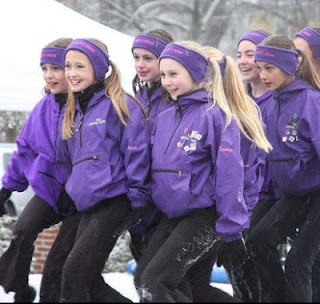


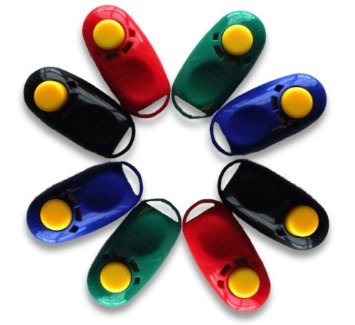





.jpg)




